A Comparative Analysis of Hidden Markov Model, Hybrid Support Vector Machines, and Hybrid Artificial Neural Fuzzy Inference System in Reservoir Inflow Forecasting (Case Study: The King Fahd Dam, Saudi Arabia)
Abstract
1. Introduction
2. Materials and Methods
2.1. Study Area Description and Dataset
2.2. Hidden Markov Model (HMM)
2.3. Support Vector Machine (SVM) Model
2.4. Adaptive Neuro-Fuzzy Inference System
2.5. Genetic Algorithm
2.6. Performance Evaluation of the Developed Models
- Nash-Sutcliffe efficiency coefficient (NSE) [59], expressed as:
- The mean absolute error (MAD), expressed as:
- The absolute variance fraction, R2, is calculated as follows:
- The root-mean-square error (RMSE), expressed as:where Qo is the measured inflow, n is the number of data points, Qf is the forecasted inflow, and is the average of the observed reservoir inflows.
2.7. Methodology
- ▪
- First of all, the quality of the investigated rainfall records was examined through absolute homogeneity tests to select homogeneous climate data series. These tests included Buishand range test, Von Neumann ratio test, and Standard normal homogeneity test. More details about these tests are described by Khadr [60].
- ▪
- The forecasting model was then selected and, consequently, the required input data.
- ▪
- The input data of the HMM model included the inflow; however, in SVM and ANFIS models, it included the data shown in Figure 4.
- ▪
- The input datasets were split into two sets, namely, training (70% of the data) and testing datasets (30% of the data).
- ▪
- The input variables were identified based on the selected model (HMM, SVM, and ANFIS).
- ▪
- The process of model training was then performed to obtain the best evaluation parameters.
- ▪
- The selected forecasting model was then tested, and the model performance was evaluated using the evaluation criteria (Equations (14)–(17)).
- ▪
- Finally, the historical observed inflow data are compared with the forecasted inflow from HMM, SVM, ANFIS, hybrid SVM-GA, and hybrid ANFIS-GA models.
3. Results
3.1. HMM
3.2. SVM and Hybrid SVM-GA Models
3.3. ANFIS and Hybrid ANFIS-GA Models
4. Discussion and Comparison of the Developed Forecasting Models
5. Conclusions
Author Contributions
Funding
Institutional Review Board Statement
Informed Consent Statement
Data Availability Statement
Acknowledgments
Conflicts of Interest
References
- Apaydin, H.; Feizi, H.; Sattari, T.M.; Colak, S.M.; Shamshirband, S.; Chao, W.K. Comparative analysis of recurrent neural network architectures for reservoir inflow forecasting. Water 2020, 12, 1500. [Google Scholar] [CrossRef]
- Peng, T.; Zhou, J.; Zhang, C.; Fu, W. Streamflow forecasting using empirical wavelet transform and artificial neural networks. Water 2017, 9, 406. [Google Scholar] [CrossRef]
- Kompor, W.; Yoshikawa, S.; Kanae, S. Use of Seasonal Streamflow Forecasts for Flood Mitigation with Adaptive Reservoir Operation: A Case Study of the Chao Phraya River Basin, Thailand, in 2011. Water 2020, 12, 3210. [Google Scholar] [CrossRef]
- Lee, S.-Y.; Hamlet, A.F.; Fitzgerald, C.J.; Burges, S.J. Optimized flood control in the Columbia River Basin for a global warming scenario. J. Water Resour. Plan. Manag. 2009, 135, 440–450. [Google Scholar] [CrossRef]
- Chang, J.; Meng, X.; Wamg, Z.Z.; Wamg, X.; Huang, Q. Optimized cascade reservoir operation considering ice flood control and power generation. J. Hydrol. 2014, 519, 1042–1051. [Google Scholar] [CrossRef]
- Hsu, N.-S.; Huang, C.-L.; Wei, C.-C. Multi-phase intelligent decision model for reservoir real-time flood control during typhoons. J. Hydrol. 2015, 522, 11–34. [Google Scholar] [CrossRef]
- Raso, L.; Chiavico, M.; Dorchies, D. Optimal and centralized reservoir management for drought and flood protection on the Upper Seine–Aube river system using stochastic dual dynamic programming. J. Water Resour. Plan. Manag. 2019, 145, 05019002. [Google Scholar] [CrossRef]
- Shen, X. Flood Risk Perception and Communication within Risk Management in Different Cultural Contexts. A Comparative Case Study between Wuhan, China, and Cologne, Germany; UNU-EHS: Bonn, Germany, 2010. [Google Scholar]
- Chan, N.W. Impacts of Disasters and Disaster Risk Management in Malaysia: The Ccase of Floods, in Resilience and Recovery in Asian Disasters; Springer: Berlin/Heidelberg, Germany, 2015; pp. 239–265. [Google Scholar]
- Zhong, Y.; Guo, S.; Ba, H.; Xiong, F.; Chang, F.J.; Lin, K. Evaluation of the BMA probabilistic inflow forecasts using TIGGE numeric precipitation predictions based on artificial neural network. Hydrol. Res. 2018, 49, 1417–1433. [Google Scholar] [CrossRef]
- Ding, Z. Overview of Measures and Assessment of Capacity for Flood Prevention and Drought Relief, in Flood Prevention and Drought Relief in Mekong River Basin; Springer: Berlin/Heidelberg, Germany, 2020; pp. 109–166. [Google Scholar] [CrossRef]
- Di Baldassarre, G.; Martinez, F.; Kalantari, Z.; Viglione, A. Drought and flood in the Anthropocene: Feedback mechanisms in reservoir operation. Earth Syst. Dyn. 2017, 8, 1–9. [Google Scholar] [CrossRef]
- Shrestha, B.B.; Kawasaki, A. Quantitative assessment of flood risk with evaluation of the effectiveness of dam operation for flood control: A case of the Bago River Basin of Myanmar. Int. J. Disaster Risk Reduct. 2020, 50, 101707. [Google Scholar] [CrossRef]
- Bai, Y.; Sun, Z.; Zeng, B.; Long, J. Reservoir inflow forecast using a clustered random deep fusion approach in the Three Gorges Reservoir, China. J. Hydrol. Eng. 2018, 23, 04018041. [Google Scholar] [CrossRef]
- Amnatsan, S.; Yoshikawa, S.; Kanae, S. Improved forecasting of extreme monthly reservoir inflow using an analogue-based forecasting method: A case study of the sirikit dam in Thailand. Water 2018, 10, 1614. [Google Scholar] [CrossRef]
- Coulibaly, P.; Haché, M.; Fortin, V.; Bobée, B. Improving daily reservoir inflow forecasts with model combination. J. Hydrol. Eng. 2005, 10, 91–99. [Google Scholar] [CrossRef]
- Zhang, Z.; Zhang, Q.; Singh, V.P. Univariate streamflow forecasting using commonly used data-driven models: Literature review and case study. Hydrol. Sci. J. 2018, 63, 1091–1111. [Google Scholar] [CrossRef]
- Wang, Z.-Y.; Qiu, J.; Li, F.-F. Hybrid models combining EMD/EEMD and ARIMA for Long-term streamflow forecasting. Water 2018, 10, 853. [Google Scholar] [CrossRef]
- Zhou, J.; Peng, T.; Zhang, C.; Sun, N. Data pre-analysis and ensemble of various artificial neural networks for monthly streamflow forecasting. Water 2018, 10, 628. [Google Scholar] [CrossRef]
- Valipour, M. Long-term runoff study using SARIMA and ARIMA models in the United States. Meteorol. Appl. 2015, 22, 592–598. [Google Scholar] [CrossRef]
- Moeeni, H.; Bonakdari, H.; Ebteha, I. Integrated SARIMA with neuro-fuzzy systems and neural networks for monthly inflow prediction. Water Resour. Manag. 2017, 31, 2141–2156. [Google Scholar] [CrossRef]
- Moeeni, H.; Bonakdari, H.; Ebteha, I. Monthly reservoir inflow forecasting using a new hybrid SARIMA genetic programming approach. J. Earth Syst. Sci. 2017, 126, 18. [Google Scholar] [CrossRef]
- Moeeni, H.; Bonakdari, H.; Fatemi, S.H.; Zaji, A.H. Assessment of stochastic models and a hybrid artificial neural network-genetic algorithm method in forecasting monthly reservoir inflow. INAE Lett. 2017, 2, 13–23. [Google Scholar] [CrossRef][Green Version]
- Chaiwattana, P.; Suiadee, W.; Songchon, C. Forecasting for hydrological data for reservoir sizing: Case study huai tha koei reservoir. In Proceedings of the 2ndworld Irrig Forum (Wif2), Chiang Mai, Thailand, 6–8 November 2016. [Google Scholar]
- Ehteram, M.; Afan, H.A.; Dianatickhah, M.; Ahmed, A.J.; Fai, C.M.; Hossain, M.S.; Allawi, M.F.; Elshafie, A. Assessing the predictability of an improved ANFIS model for monthly streamflow using lagged climate indices as predictors. Water 2019, 11, 1130. [Google Scholar] [CrossRef]
- Chang, L.-C.; Amin, M.Z.M.; Yang, S.N.; Chang, F.J. Building ANN-based regional multi-step-ahead flood inundation forecast models. Water 2018, 10, 1283. [Google Scholar] [CrossRef]
- Kişi, Ö. River flow modeling using artificial neural networks. J. Hydrol. Eng. 2004, 9, 60–63. [Google Scholar] [CrossRef]
- Khadr, M.; Schlenkhoff, A. Data-driven stochastic modeling for multi-purpose reservoir simulation. J. Appl. Water Eng. Res. 2018, 1, 40–47. [Google Scholar] [CrossRef]
- Noori, R.; Karbassi, A.R.; Mehdizadeh, H.; Vesali, N.M.; Sabahi, M.S. A framework development for predicting the longitudinal dispersion coefficient in natural streams using an artificial neural network. Environ. Prog. Sustain. Energy 2011, 30, 439–449. [Google Scholar] [CrossRef]
- Kişi, Ö. Neural networks and wavelet conjunction model for intermittent streamflow forecasting. J. Hydrol. Eng. 2009, 14, 773–782. [Google Scholar] [CrossRef]
- Adnan, R.M.; Yuan, X.; Kisi, O.; Yuan, Y. Streamflow forecasting using artificial neural network and support vector machine models. Am. Sci. Res. J. Eng. Technol. Sci. 2017, 29, 286–294. [Google Scholar]
- Dariane, A.B.; Azimi, S. Streamflow forecasting by combining neural networks and fuzzy models using advanced methods of input variable selection. J. Hydroinform. 2018, 20, 520–532. [Google Scholar] [CrossRef]
- Mohammadi, K.; Eslami, H.; Dayani, D.S. Comparison of regression, ARIMA and ANN models for reservoir inflow forecasting using snowmelt equivalent (a case study of Karaj). J. Agric. Sci. Technol. 2005, 7, 17–30. [Google Scholar]
- Valipour, M.; Banihabib, M.E.; Behbahani, S.M.R. Comparison of the ARMA, ARIMA, and the autoregressive artificial neural network models in forecasting the monthly inflow of Dez dam reservoir. J. Hydrol. 2013, 476, 433–441. [Google Scholar] [CrossRef]
- Zhang, G.P. Time series forecasting using a hybrid ARIMA and neural network model. Neurocomputing 2003, 50, 159–175. [Google Scholar] [CrossRef]
- Cheng, C.-T.; Feng, Z.K.; Niu, W.J.; Liao, S.L. Heuristic methods for reservoir monthly inflow forecasting: A case study of Xinfengjiang Reservoir in Pearl River, China. Water 2015, 7, 4477–4495. [Google Scholar] [CrossRef]
- Mosavi, A.; Ozturk, P.; Chau, K.-W. Flood prediction using machine learning models: Literature review. Water 2018, 10, 1536. [Google Scholar] [CrossRef]
- Dibike, Y.B.; Velickov, S.; Solomatine, D.; Abott, M.B. Model induction with support vector machines: Introduction and applications. J. Comput. Civ. Eng. 2001, 15, 208–216. [Google Scholar] [CrossRef]
- Parsaie, A.; Yonesi, H.A.; Najafian, S. Predictive modeling of discharge in compound open channel by support vector machine technique. Modelling Earth Syst. Environ. 2015, 1, 1. [Google Scholar] [CrossRef]
- Kisi, O. Streamflow forecasting and estimation using least square support vector regression and adaptive neuro-fuzzy embedded fuzzy c-means clustering. Water Resour. Manag. 2015, 29, 5109–5127. [Google Scholar] [CrossRef]
- Ghorbani, M.A.; Khatibi, R.; Goel, A.; Falezi, F.H.A.; Azani, A. Modeling river discharge time series using support vector machine and artificial neural networks. Environ. Earth Sci. 2016, 75, 685. [Google Scholar] [CrossRef]
- Chau, K.; Wu, C.; Li, Y. Comparison of several flood forecasting models in Yangtze River. J. Hydrol. Eng. 2005, 10, 485–491. [Google Scholar] [CrossRef]
- Long, Y.; Tang, R.; Wang, H.; Jiang, C. Monthly precipitation modeling using Bayesian non-homogeneous hidden Markov chain. Hydrol. Res. 2019, 50, 562–576. [Google Scholar] [CrossRef]
- Khadr, M. Forecasting of meteorological drought using Hidden Markov Model (case study: The upper Blue Nile river basin, Ethiopia). Ain Shams Eng. J. 2016, 7, 47–56. [Google Scholar] [CrossRef]
- Hernández, L.C.H.; Reis, D.S., Jr. Seasonal Inflow Forecasts Based on Non-Homogeneous Hidden Markov Models: The Case of Orós Reservoir, Northeastern Brazil. In World Environmental and Water Resources Congress 2018: Watershed Management, Irrigation and Drainage, and Water Resources Planning and Management; American Society of Civil Engineers: Reston, VA, USA, 2018; pp. 269–277. [Google Scholar]
- Rolim, L.Z.R.; de Souza Filho, F.D.A. Shift Detection in Hydrological Regimes and Pluriannual Low-Frequency Streamflow Forecasting Using the Hidden Markov Model. Water 2020, 12, 2058. [Google Scholar] [CrossRef]
- Hernadez, H.L.C.; Silveira, R.D., Jr. Forecasting inflow persistence using climate-informed Hidden Markov Models: An Application to Orós Reservoir in Brazil. In Proceedings of the 20th EGU General Assembly, EGU2018. Vienna, Austria, 4–13 April 2018; p. 16889. [Google Scholar]
- Keilson, J. Markov chain models--rarity and exponentiality. In Applied Mathematical Ssciences; Springer: New York, NY, USA, 1979; p. 184. [Google Scholar]
- Liu, Y.; Ye, L.; Qin, H.; Hong, X.; Ye, J.; Yin, X. Monthly streamflow forecasting based on hidden Markov model and Gaussian Mixture Regression. J. Hydrol. 2018, 561, 146–159. [Google Scholar] [CrossRef]
- Elliott, R.J.; Aggoun, L.; Moore, J.B. Hidden Markov Models: Estimation and Control. In Applications of Mathematics; Springer: New York, NY, USA, 1995; p. 361. [Google Scholar]
- MacDonald, I.L.; Zucchini, W. Hidden Markov and other models for discrete-valued time series. In Monographs on Statistics and Applied Probability, 1st ed.; Chapman & Hall: New York, NY, USA; London, UK, 1997; p. 236. [Google Scholar]
- Zucchini, W.; MacDonald, I.L. Hidden Markov models for time series: An introduction using R. In Monographs on Statistics and Applied Probability; CRC Press: Boca Raton, FL, USA, 2009; p. 275. [Google Scholar]
- Mares, I.C.M. A hidden Markov model for the Orsova discharge level in springtime. In Proceedings of the BALWOIS 2008, Ohrid, North Macedonia, 27–31 May 2008. [Google Scholar]
- Buhlmann, P.; Wyner, A.J. Variable length Markov chains. Ann. Stat. 1999, 27, 480–513. [Google Scholar] [CrossRef]
- Steeb, W.H. The Nonlinear Wrkbook : Chaos, Fractals, Cellular Automata, Neural Networks, Genetic Algorithms, Gene Expression Programming, Support Vector Machine, Wavelets, Hidden Markov Models, Fuzzy Logic with C++, Java and SymbolicC++ Programs, 4th ed.; World Scientific: New Jersey, NJ, USA, 2008; p. 605. [Google Scholar]
- Müller, K.-R.; Smol, A.J.; Rätsch, G.; Schölkopf, B.; Kohlmorgen, J.; Vapnik, V. Predicting Time Series with Support Vector Machines. In International Conference on Artificial Neural Networks; Springer: Berlin/Heidelberg, Germany, 1997. [Google Scholar]
- Zadeh, L.A. Outline of a new approach to the analysis of complex systems and decision processes. IEEE Trans. Syst. Man Cybern. 1973, 1, 28–44. [Google Scholar] [CrossRef]
- Abuhasel, K.A. Machine learning approach to handle data-driven model for simulation and forecasting of the cone crusher output in the stone crushing plant. Comput. Intell. 2020. [Google Scholar] [CrossRef]
- Nash, J.E.; Sutcliffe, J.V. River flow forecasting through conceptual models part I—A discussion of principles. J. Hydrol. 1970, 10, 282–290. [Google Scholar] [CrossRef]
- Khadr, M. Temporal and spatial patterns of rainfall variability using nonparametric methods and wavelet transform: A case study of Sinai Peninsula. Arab. J. Geosci. 2021, 14, 1–22. [Google Scholar] [CrossRef]
- Yaseen, Z.M.; Ebtehaj, I.; Bonakdari, H.; Deo, C.R.; Mehr, A.D.; Mohar, W.M.H.W.; Diop, L.; El-Shafie, A.; Singh, V.P. Novel approach for streamflow forecasting using a hybrid ANFIS-FFA model. J. Hydrol. 2017, 554, 263–276. [Google Scholar] [CrossRef]
- Shafaei, M.; Kisi, O. Predicting river daily flow using wavelet-artificial neural networks based on regression analyses in comparison with artificial neural networks and support vector machine models. Neural Comput. Appl. 2017, 28, 15–28. [Google Scholar] [CrossRef]
- Zhou, Y.; Guo, S.; Chang, F.J. Explore an evolutionary recurrent ANFIS for modelling multi-step-ahead flood forecasts. J. Hydrol. 2019, 570, 343–355. [Google Scholar] [CrossRef]
- Su, J.; Wang, X.; Liang, Y.; Chen, B. GA-based support vector machine model for the prediction of monthly reservoir storage. J. Hydrol. Eng. 2014, 19, 1430–1437. [Google Scholar] [CrossRef]
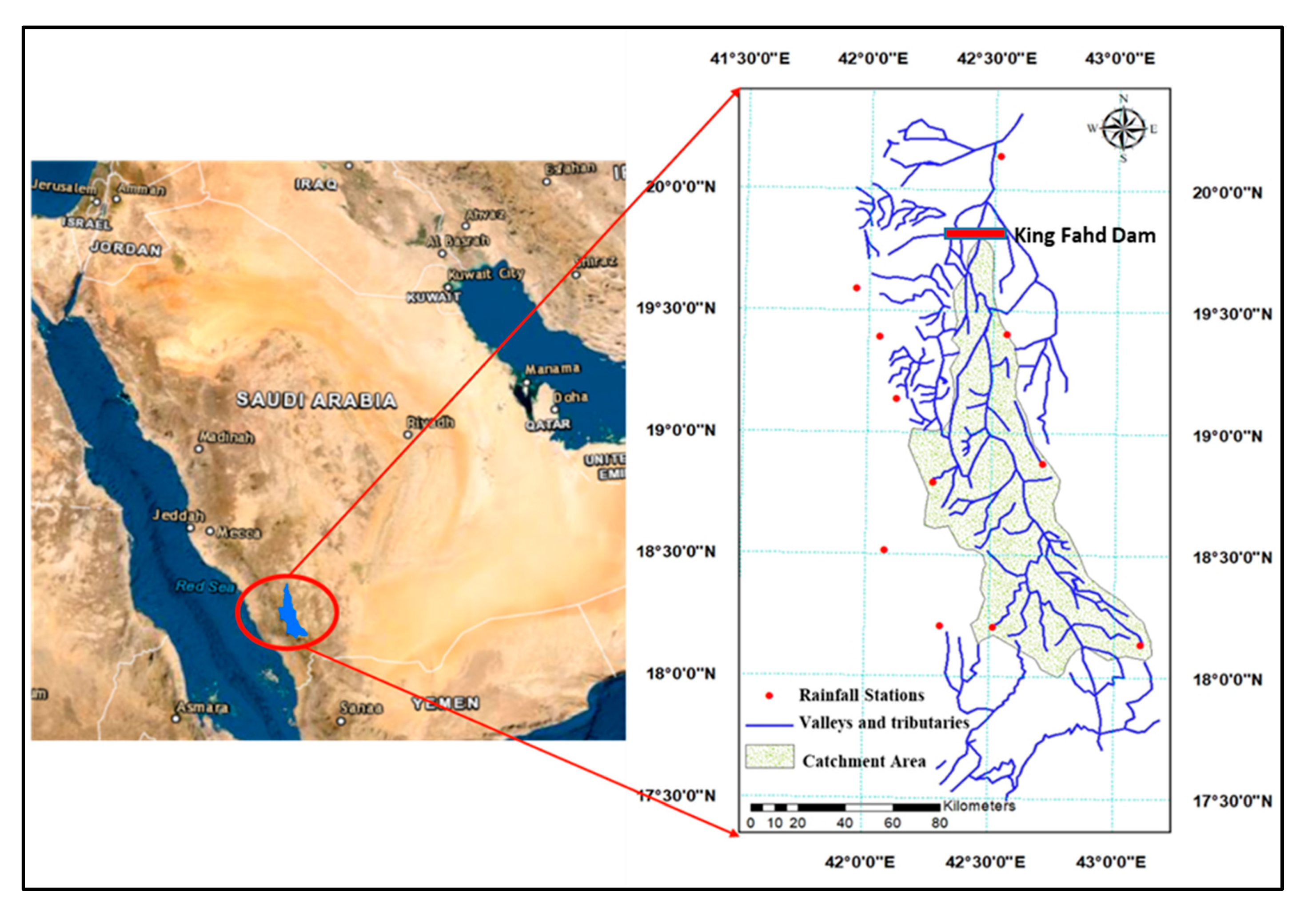
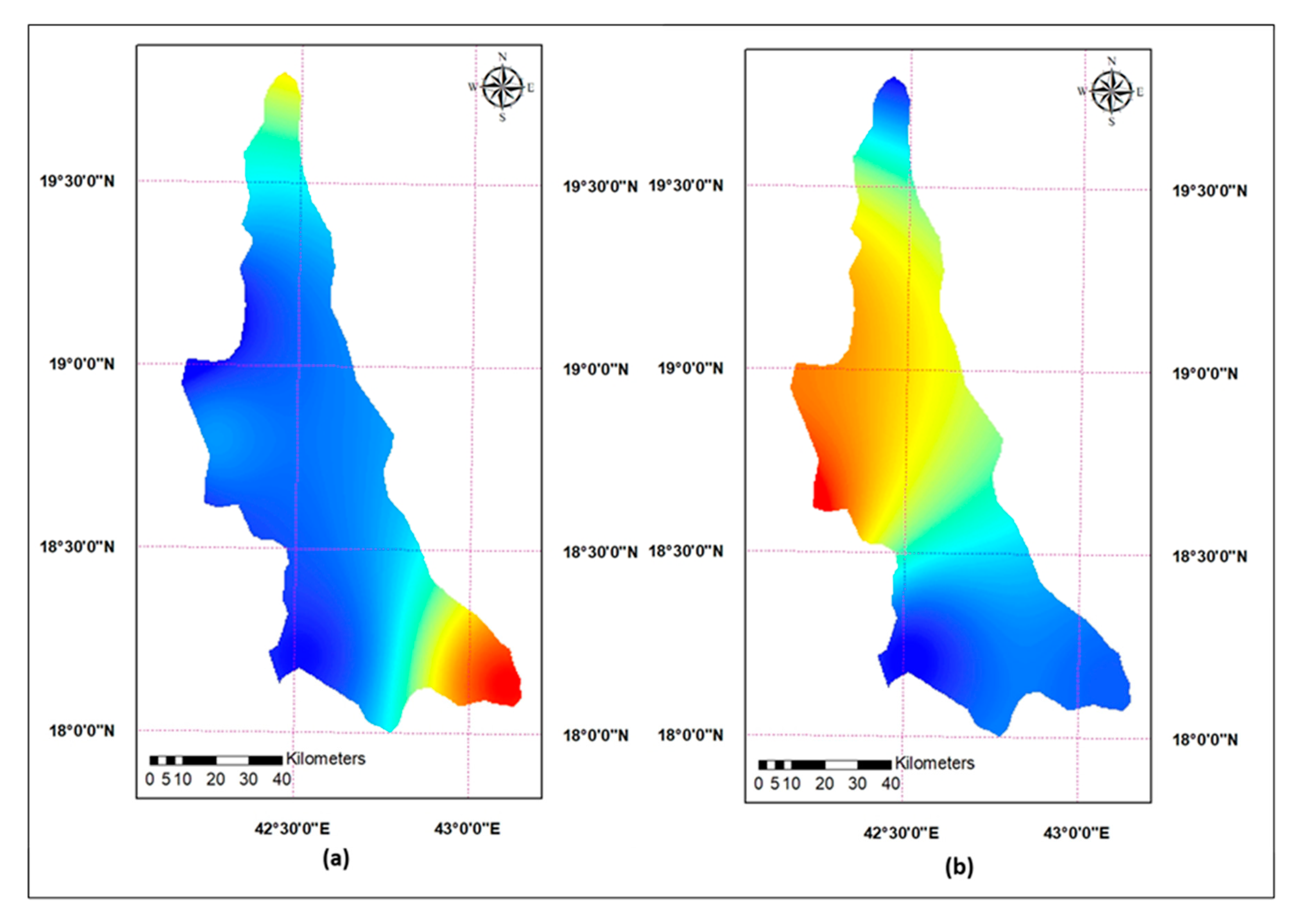
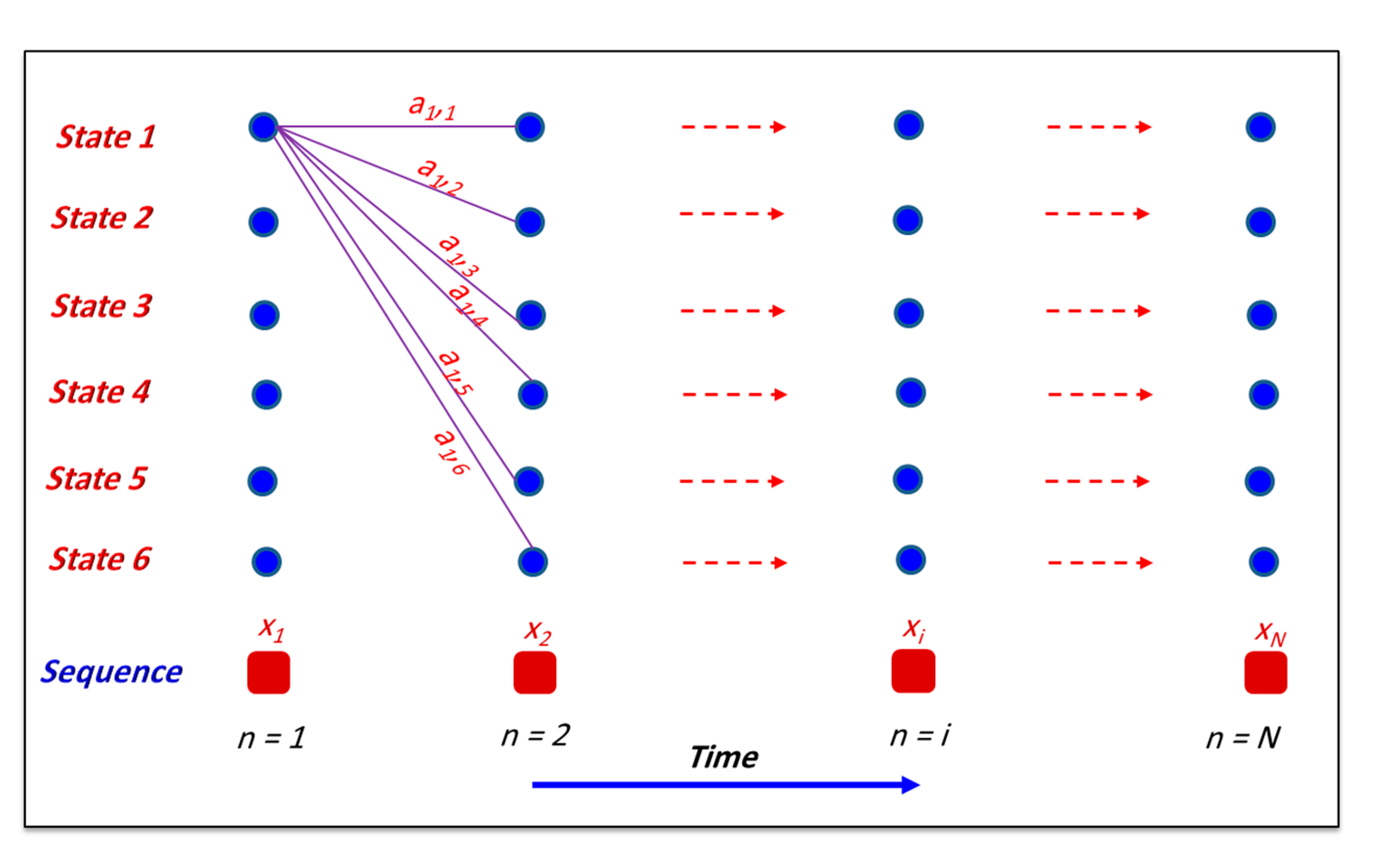
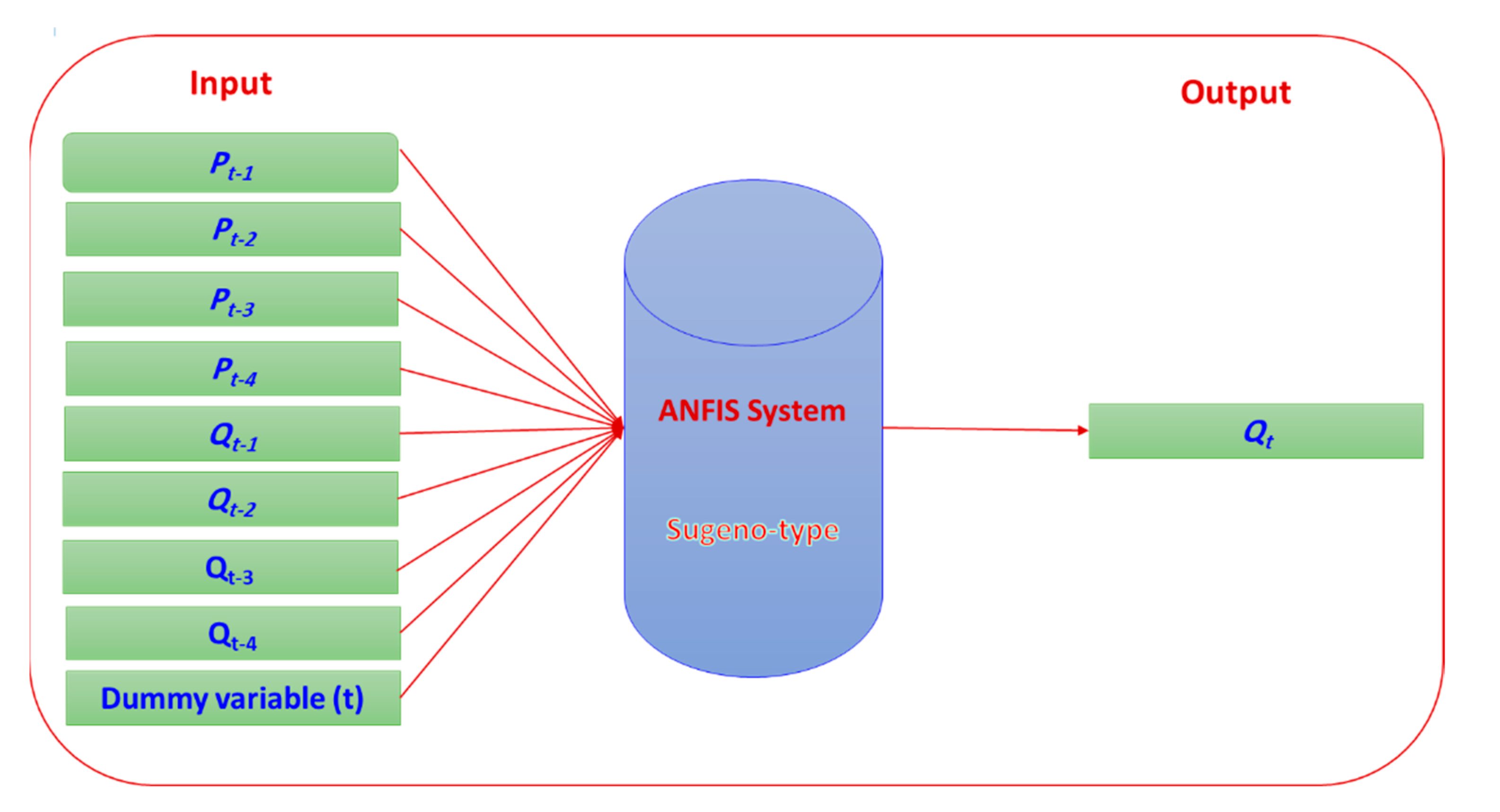
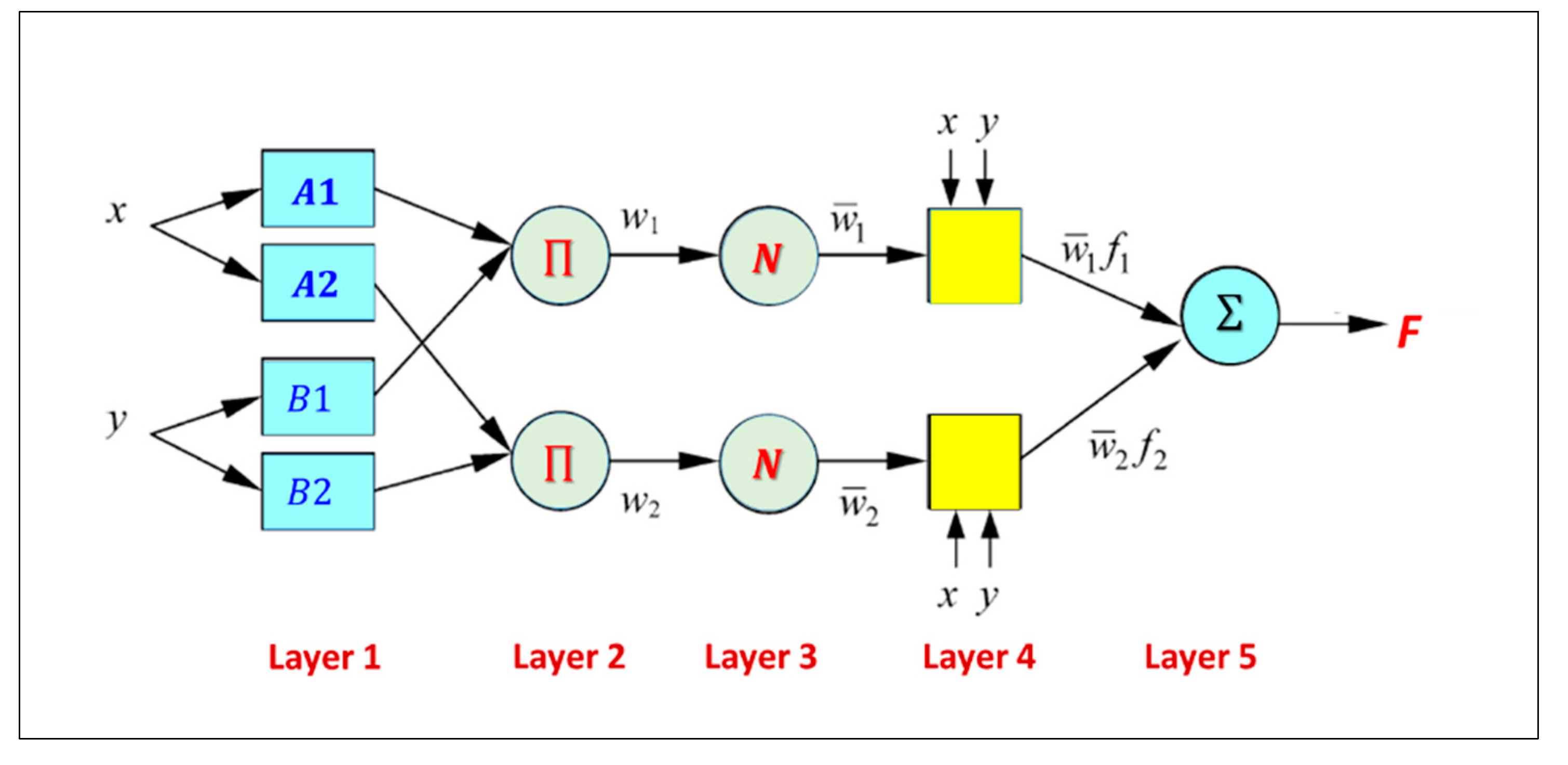
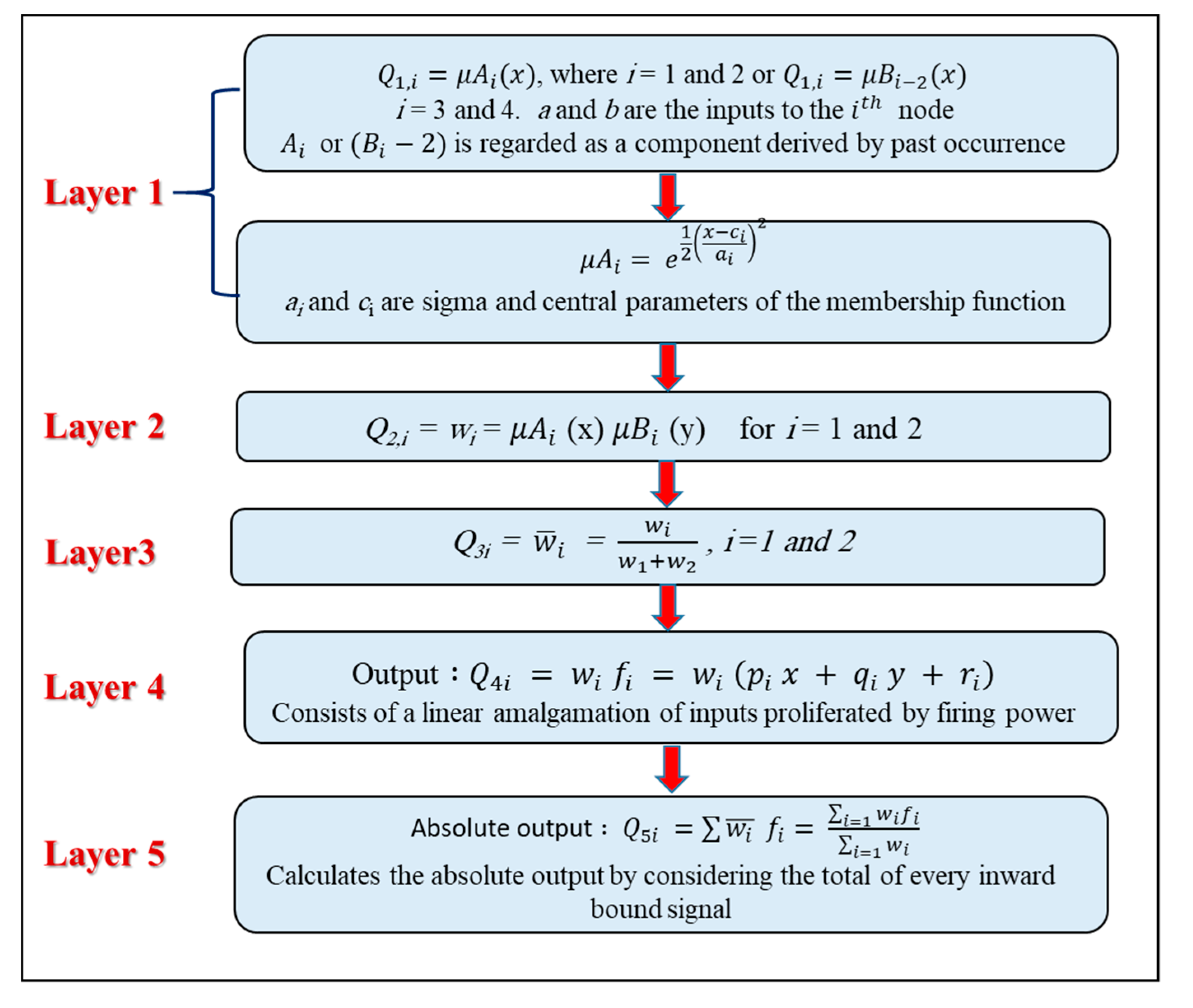
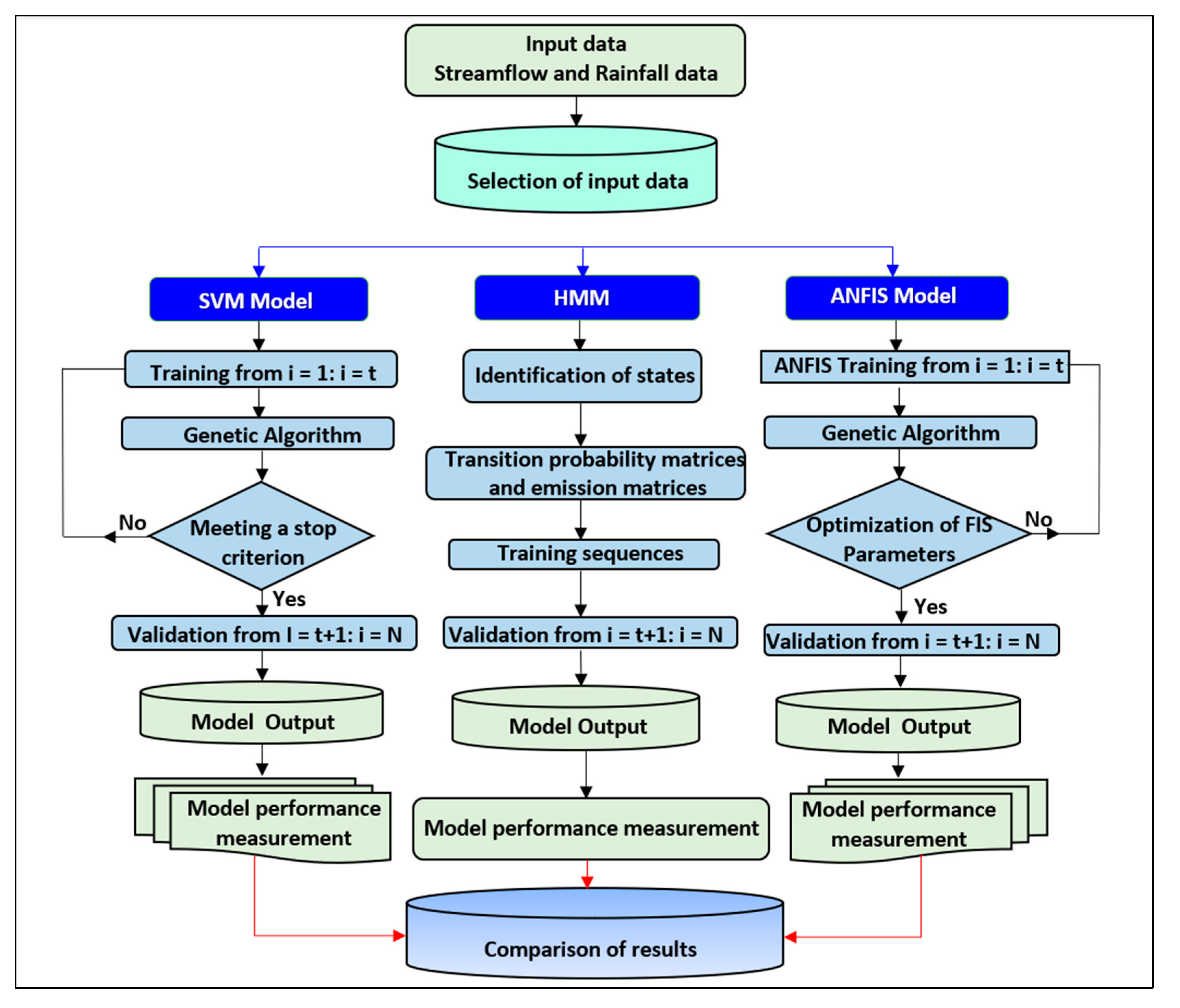
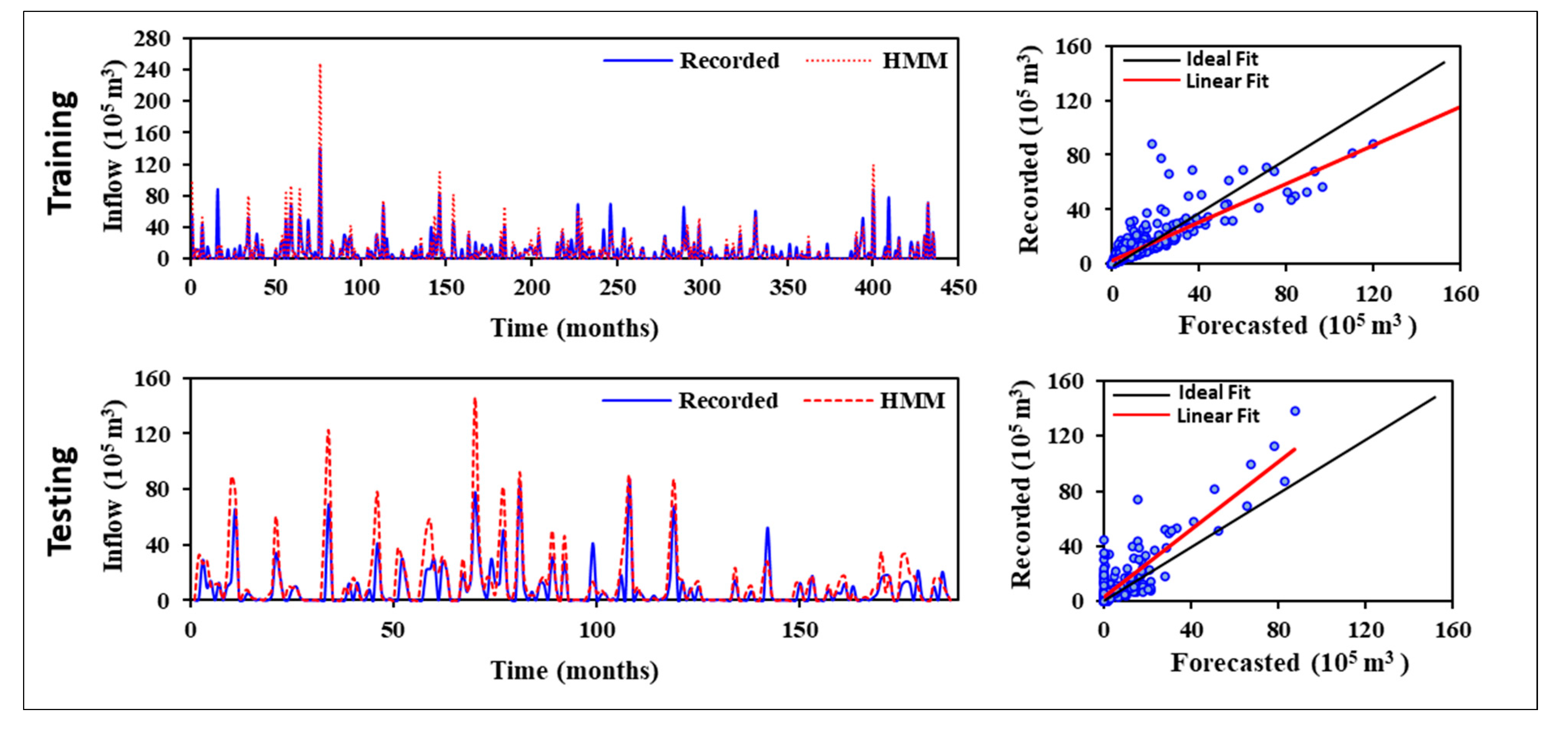
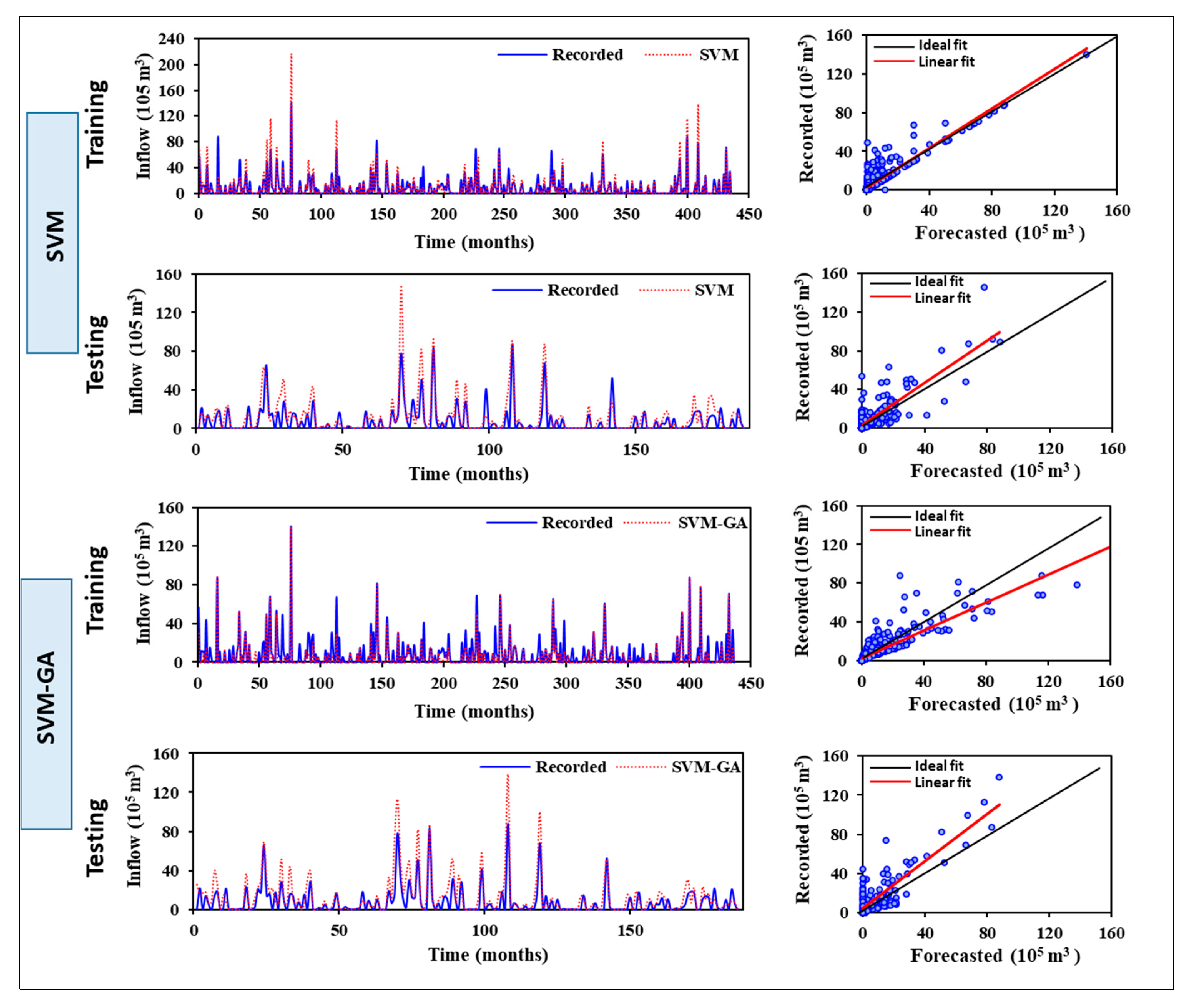
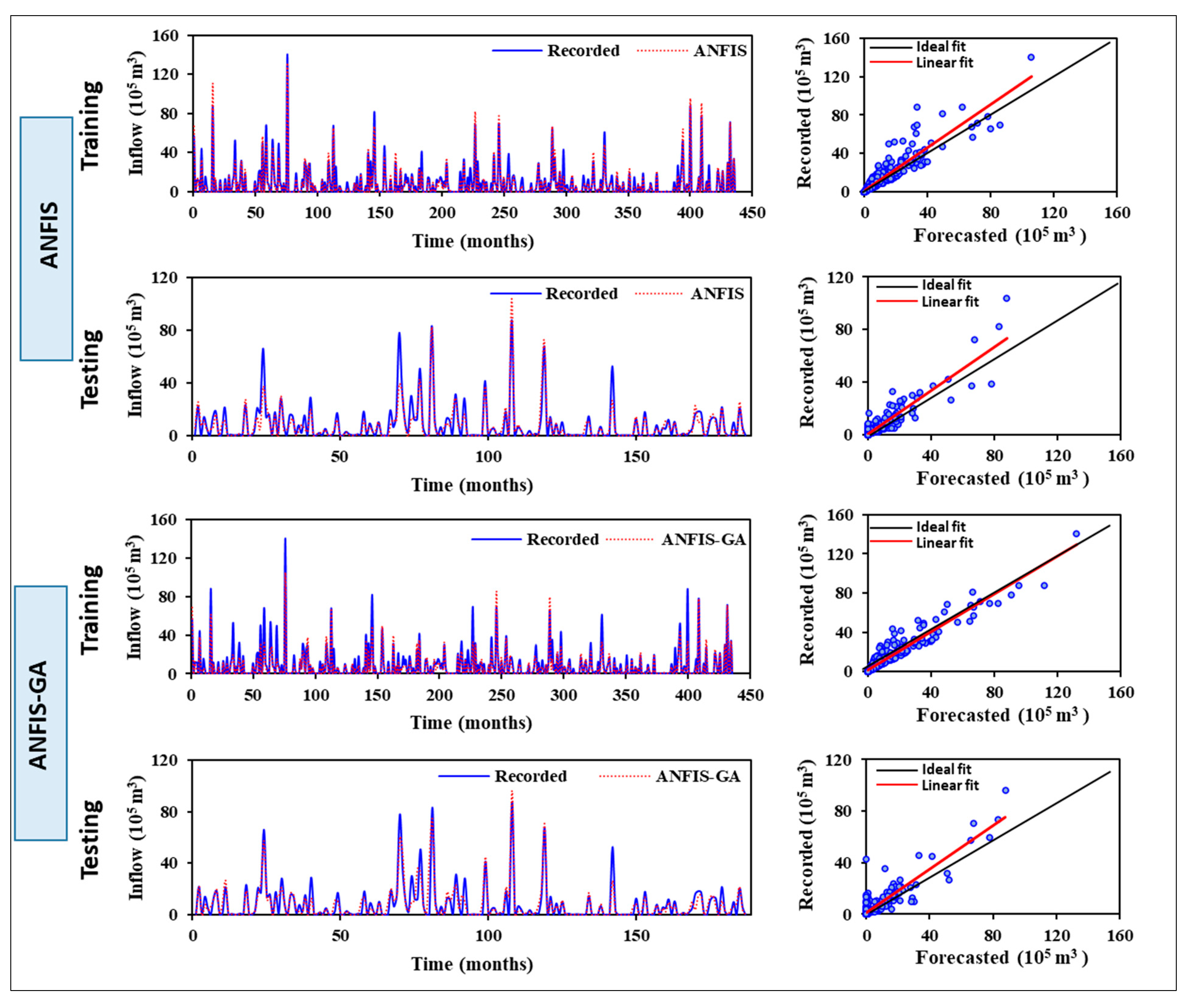
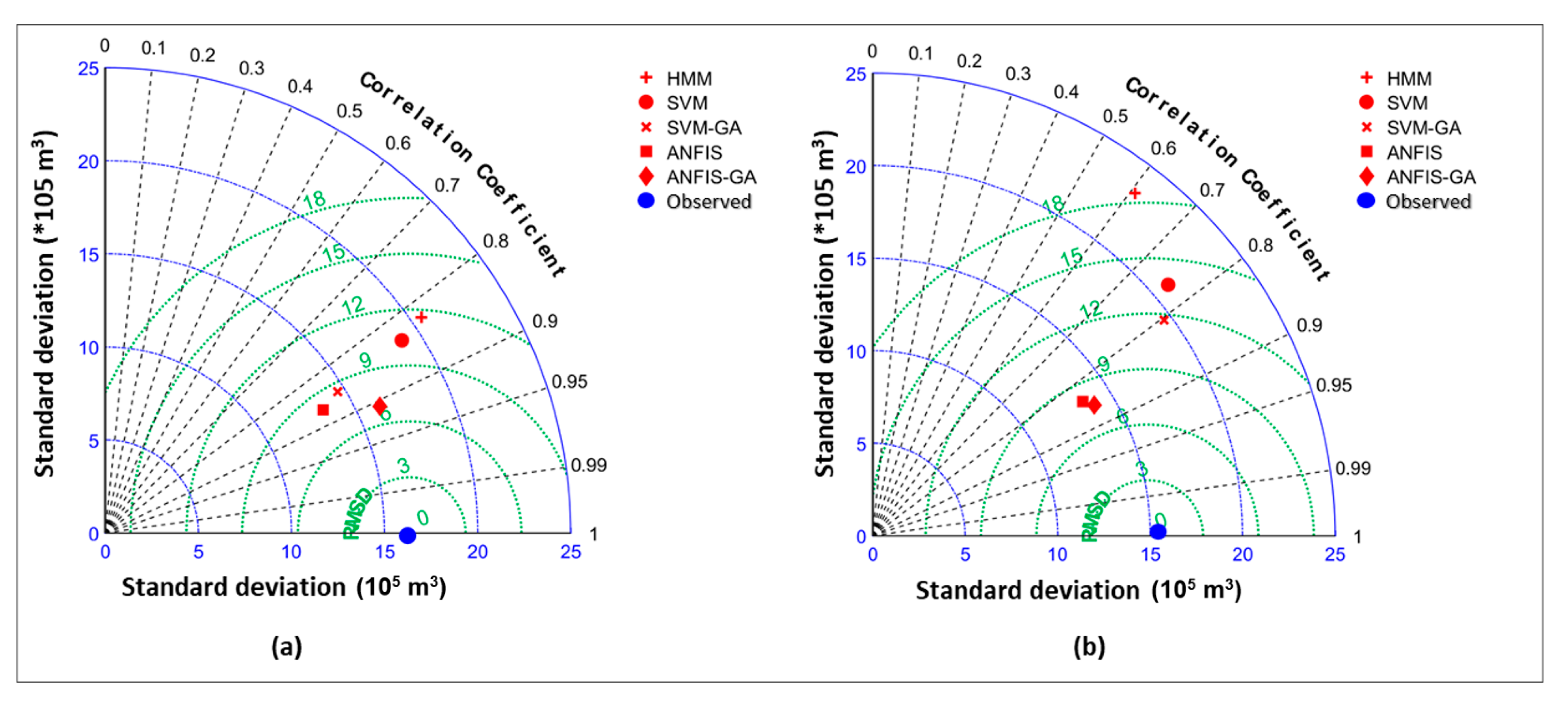
| Months | Jan. | Feb. | Mar. | Apr. | May | Jun. | Jul. | Aug. | Sep. | Oct. | Nov. | Dec. |
|---|---|---|---|---|---|---|---|---|---|---|---|---|
| State | Inflow (Million m3) | |||||||||||
| 1 | >50 | >100 | >80 | >80 | >140 | >45 | >68 | >40 | >29 | >34 | >33 | >31 |
| 2 | 41–50 | 81–100 | 61–80 | 61–80 | 112–140 | 36–45 | 53–68 | 31–40 | 23–29 | 28–34 | 27–33 | 25–31 |
| 3 | 31–40 | 61–80 | 41–60 | 41–60 | 81–110 | 26–35 | 38–53 | 21–30 | 16–22 | 21–27 | 19–26 | 18–24 |
| 4 | 21–30 | 41–60 | 21–40 | 21–40 | 51–80 | 16–25 | 23–38 | 11–20 | 9–15 | 14–20 | 13–19 | 11–17 |
| 5 | 10–20 | 20–40 | 10–20 | 10–20 | 20–50 | 5–15 | 8–23 | 2–10 | 1–8 | 6–13 | 5–12 | 3–10 |
| 6 | <10 | <20 | <10 | <10 | <20 | <5 | <8 | <2 | <1 | <6 | <5 | <3 |
| Model | Performance Criteria | ||||
|---|---|---|---|---|---|
| R2 | RMSE | MAD | E | ||
| Training Series | HMM | 0.683 | 9.76E + 06 | 3.75E + 06 | 0.643 |
| SVM | 0.703 | 9.19E + 06 | 3.71E + 06 | 0.683 | |
| SVM-GA | 0.730 | 7.42E + 06 | 3.18E + 06 | 0.794 | |
| ANFIS | 0.757 | 6.71E + 06 | 2.72E + 06 | 0.831 | |
| ANFIS-GA | 0.824 | 4.67E + 06 | 2.21E + 06 | 0.918 | |
| Testing Series | HMM | 0.370 | 1.95E + 07 | 1.04E + 07 | −0.735 |
| SVM | 0.581 | 1.18E + 07 | 6.47E + 06 | 0.363 | |
| SVM-GA | 0.647 | 1.22E + 07 | 6.98E + 06 | 0.322 | |
| ANFIS | 0.710 | 6.48E + 06 | 3.39E + 06 | 0.809 | |
| ANFIS-GA | 0.742 | 5.93E + 06 | 3.18E + 06 | 0.840 | |
Publisher’s Note: MDPI stays neutral with regard to jurisdictional claims in published maps and institutional affiliations. |
© 2021 by the authors. Licensee MDPI, Basel, Switzerland. This article is an open access article distributed under the terms and conditions of the Creative Commons Attribution (CC BY) license (https://creativecommons.org/licenses/by/4.0/).
Share and Cite
Alquraish, M.M.; Abuhasel, K.A.; Alqahtani, A.S.; Khadr, M. A Comparative Analysis of Hidden Markov Model, Hybrid Support Vector Machines, and Hybrid Artificial Neural Fuzzy Inference System in Reservoir Inflow Forecasting (Case Study: The King Fahd Dam, Saudi Arabia). Water 2021, 13, 1236. https://doi.org/10.3390/w13091236
Alquraish MM, Abuhasel KA, Alqahtani AS, Khadr M. A Comparative Analysis of Hidden Markov Model, Hybrid Support Vector Machines, and Hybrid Artificial Neural Fuzzy Inference System in Reservoir Inflow Forecasting (Case Study: The King Fahd Dam, Saudi Arabia). Water. 2021; 13(9):1236. https://doi.org/10.3390/w13091236
Chicago/Turabian StyleAlquraish, Mohammed M., Khaled A. Abuhasel, Abdulrahman S. Alqahtani, and Mosaad Khadr. 2021. "A Comparative Analysis of Hidden Markov Model, Hybrid Support Vector Machines, and Hybrid Artificial Neural Fuzzy Inference System in Reservoir Inflow Forecasting (Case Study: The King Fahd Dam, Saudi Arabia)" Water 13, no. 9: 1236. https://doi.org/10.3390/w13091236
APA StyleAlquraish, M. M., Abuhasel, K. A., Alqahtani, A. S., & Khadr, M. (2021). A Comparative Analysis of Hidden Markov Model, Hybrid Support Vector Machines, and Hybrid Artificial Neural Fuzzy Inference System in Reservoir Inflow Forecasting (Case Study: The King Fahd Dam, Saudi Arabia). Water, 13(9), 1236. https://doi.org/10.3390/w13091236






